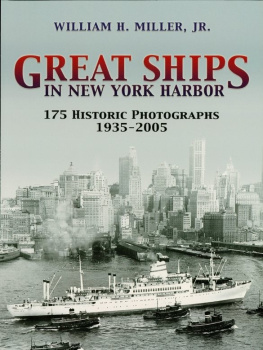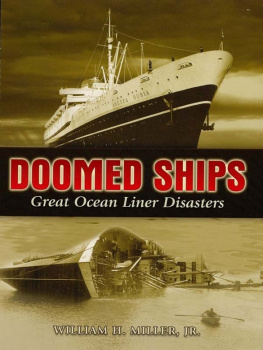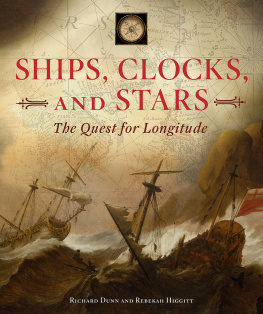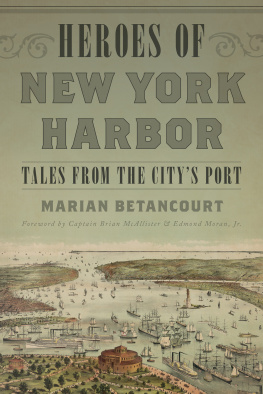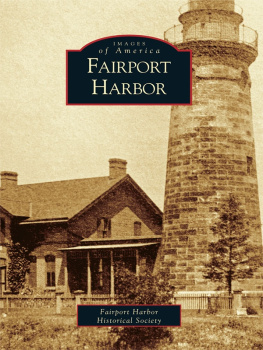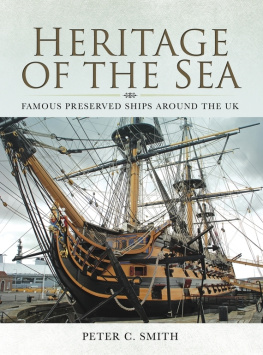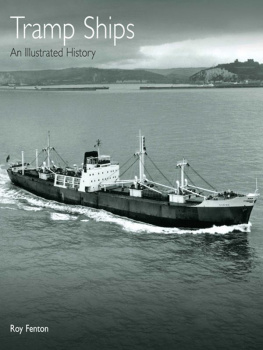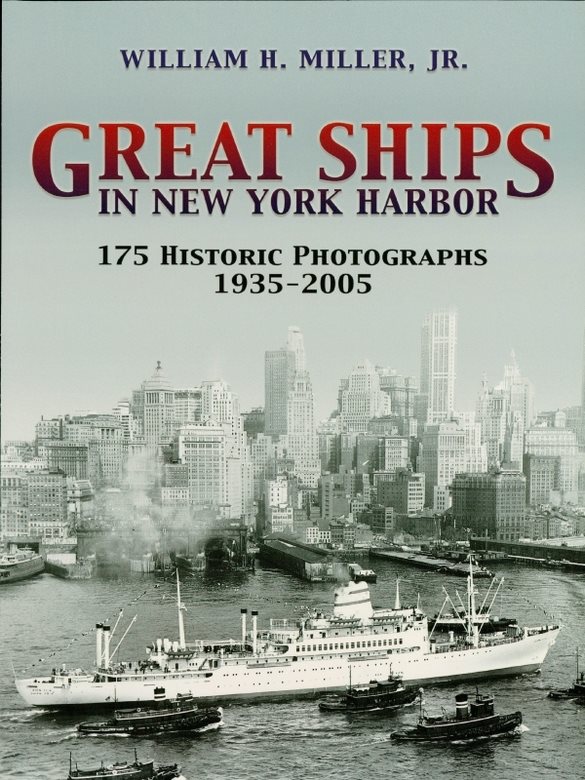Acknowledgments
Just as there was a huge castthe crews, the dockers, the shipyard workers, the floating crane operators, the firefighters onboard the fireboats, and the narrators on the Circle Line, there was also a good-size cast that assisted me in the organization, creation, and final production of this photo-filled book. It has been a pleasure voyage for me of pure nostalgia.
First of all, my greatest appreciation and respect for the splendid Dover Publications. They have had ongoing, undiminished interest and enthusiasm for maritime titles over the past 25 years, beginning in 1979 from my first meetings with the late Hayward Cirker and his expert staff at Dovers Varick Street offices. Mr. Cirker was a tireless promoter, inspiration, and the greatest of instigators for these nautical picture books. In particular, he so enjoyed documenting all aspects of history, life, and the ongoing human process. Fortunately, based on his young days on Atlantic crossings, he was fascinated by passenger ships. These days, at Dover, I am deeply indebted to some of his successors: Clarence Strowbridge, for taking these titles on; Suzanne E. Johnson, for her editorial skills and sense of accuracy and detail; and to Carol Belanger Grafton, for her flawless design and layout.
Away from Dover itself, the crew that provides photos, information, and the smallest of helpful details begins with a first-class group that includes Ernest Arroyo, Frank Braynard, Kitty Carlisle Hart, Tom Cassidy, the late Frank Cronican, Captain Dag Dvergastein, Richard Faber, the late John Gillespie, Norman Knebel, Captain James McNamara, Richard Morse, Sal Scannella, Jane Bouche Strong, and Commodore Ronald Warwick. They are never reluctant, or hesitant, to loan that prized picture, share their knowledge, or provide some other element of support and assistance. Highest praises to Abe Michaelson, my business partner, who promotes, sells, and distributes books such as these to all the seven seas. I would also like to extend my warmest thanks to Anthony Cooke, Luis Miguel Correia, Maurizio Eliseo, James Flood, James Giammatteo, the late Jacob Goldstein, Andy Hernandez, the late Captain Fred Johnson, Arnold Kludas, Peter Lancaric, Stan Lehrer, Victor Marinelli, the late Captain Joseph Mazzotta, Hisashi Noma, Harold Oshzy, Robert Pelletier, Paolo Piccione, Fred Rodriguez, Rich Romano, the late Victor Scrivens, Captain Ed Squire, Gordon Turner, Jack Watson, and Al Wilhelmi. Theres also need to mention Frank Andrews, Tom Chirby, and Steve Cryan.
Firms and organizations that greatly assisted include Alcoa Steamship Company, Carmania Press Limited, Carnival Cruise Lines, Celebrity Cruises, Crystal Cruises, Cunard Line, Hoboken Museum & Historical Society, Moran Towing & Transportation Company, the Ocean Liner Council at the South Street Seaport Museum, Port Authority of New York & New Jersey, RadissonSeven Seas Cruises, Sea-Land Corporation, Steamship Historical Society (especially the Long Island Chapter), World Ocean & Cruise Society, and the World Ship Society. There are also those companies which are, alas, no more, such as American Export Lines, Bethlehem Steel Company, Erie Railroad, Flying Camera, Inc., and the French Line. If I have failed to mention anyone else, my great apologies. But know that you are all well appreciated and have assisted in keeping a part of our maritime history alive.
Afterword
New York harbor is indeed a magical place. On a Saturday morning in early June 2004, the setting was superb. The citys weather was flawless. The skies overhead were ink blue, the light soft and clear, the visibility crystalline and seemingly limitless. You could almost see all the way to Portugal!
We were fortunate: a boat ride was in our schedule. On a chartered craft with several hundred fellow guests aboard, our journey had, in fact, a very specific purpose: the 100th anniversary of the tragic burning and near-sinking of the steamer General Slocum. Some 957 perished in the churning, Long Island Sound waters just north of Hell Gate. Once at the site, there were commemorative speeches, a narrative, and the tossing of wreaths and carnations. A clergyman added a blessing while several surrounding boats paused in momentary vigil as a city fireboat elegantly sprayed great hoops of colored water. Whistles then sounded in rightful homage, followed by a deep silence. Those lost souls were fittingly remembered.
We had undocked from Lower Manhattan, from the piers of South Street Seaport Museum and where, decades before, passenger ships, tramp steamers, and those ever-romantic banana boats had cast off for the likes of Havana, Vera Cruz, and Cartagena. An immortal ship, the liner Morro Castle, which hideously burned off the New Jersey shore in September 1934 with the loss of 122 passengers and crew, used nearby Pier 15, one dock to the north. Our boat swung out and then turned north, eventually moving along the mighty East River and under that trio of illustrious bridges: the Brooklyn, the Manhattan, and the Williamsburg.
While Manhattans cityscape is dominated by those great skyscrapers, the opposite Brooklyn shore is lower, gentler, perhaps less inhibiting and more individualistic. There, in melancholy splendor, also sat the great warehouses, factories, and piers that once pulsated, hummed and drummed, and churned with commerce and trade and, of course, shipping. I thought back to those busier times, to the 1950s and 60s, when those very docks were crammed with freighters, their matchstick-like booms swung in every direction, loading and off-loading freight of every kind and type, and from the far corners of the earth: Capetown, Hamburg, Yokohama, Valparaiso, and Trinidad. There was the Meyer Line, Farrell Lines, Moore-McCormack Lines, Grancolombiana, the Elder Dempster Lines, NYK Line, and the Barber Line. And they were the names belonging to just the upper-Brooklyn docks. Dozens and dozens were left to the lower Brooklyn waterfront, extending southward to the mammoth Army Terminal down at 58th Street.
I even loved the smells of those old Brooklyn docks. There were the smells of the hemp lines, the smells of the combinations of the oils and the greases, the smells of our cargoes, the smells of the wood pilings and, of course, the smells of the river itself, remembered Captain Dag Dvergastein, present-day master of an ultra-luxurious cruise ship, the Seven Seas Voyager. Then, however, the young Dag was a junior on Norwegian-flag, Barber Line freighters. Barber was actually the American agents name. The ships belonged to the Oslo-based Wilhelmsen Lines, and possibly best remembered for their impeccable freighters, which all had names that began with the letter T. Dag served aboard the likes of the Taronga, Tegola, Trianon, Tennessee, and Taiping . We would lay over in the Brooklyn docks for days at a time, usually a full week in fact, off-loading and then reloading for the next voyage. It all took much longer, even in the 1970s, as the changeover to full containers was not yet complete. I often did the night watch onboard, sometimes casting a glance backward at the great Manhattan skyline, those towers glowing and reaching for the sky. The combination of ship, pier, cargo, and the city was fascinating, intoxicating, absolute poetry.
The Barber Line freighters carried an enormous range of freight in their six, seven, even eight holds. We were like floating supermarkets, noted the Captain. We would have mail, shirts, California apples, steel, bourbon, bags of corn, and American-made cars encased in plywood. Wed also have toys from Taiwan, automobile parts from Japan, bed sheets from China, latex and tapioca from Bangkok, and yet other items such as canned sardines, fireworks, clocks, and construction equipment. We had a very organized routing in those days, from Brooklyn to the Panama Canal and the West Coast before heading for the Far East. Afterward, we would return from the East again through Panama and stopping in the Caribbean before calling at a succession of U.S. ports before returning to Brooklyn. The full voyage took as long as four or five months.

